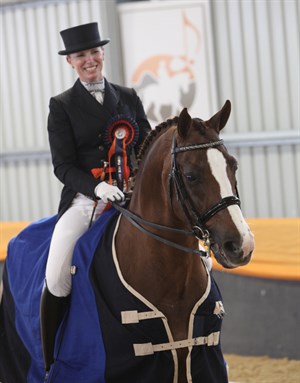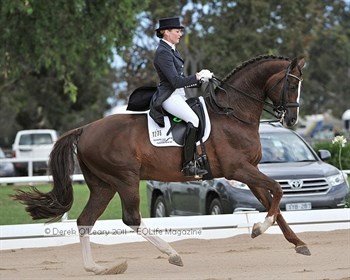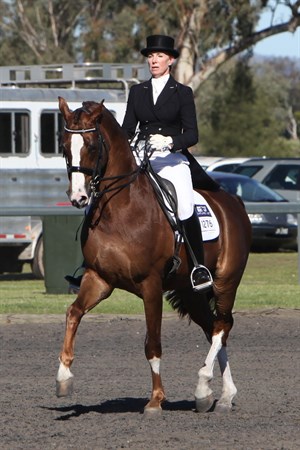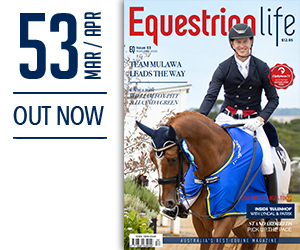|

|
This article first appeared in Issue 19 of Equestrian Life magazine. For more information or to subscribe, visit our home page here.

Gina Montgomery and Rodrigo III.
© Roger Fitzhardinge
By Roger Fitzhardinge
There are many good riders in the dressage world, but what makes one more competitive than the next? A rider is only as competitive as the horse they have under them and the partnership is a two-way experience.
Being given the chance to train and compete on an experienced horse means being given the chance to improve your own riding. A top horse will give the rider the correct feeling for all the movements at the highest level. Many dedicated and serious riders try to source such a horse, and when one comes along, it's a real bonus to any aspiring rider. So, when Gina Montgomery was given the chance to sit on a very good horse, Rodrigo III (then owned by Maree Tomkinson) she knew it was her chance to step up. However, she also knew it could be like having the fastest car in a race: unless you learn how to move through the gears, take the corners and drive in all weather conditions, you are doomed. It's certainly an advantage to be in the fastest car or on the fanciest horse, but you still have to take the time to gain the experience of driving or riding well to win.

Maree Tomkinson and Rodrigo III.
© Derek O'Leary
Gina started riding as a young girl with dreams of winning garlands and broad sashes at royal shows on beautiful ponies, galloways and hacks. Her dedication, despite having parents who were totally foreign to the equestrian world but supported her dreams, meant her dream soon became reality. Driven by a burning desire to be the best, Gina was an avid watcher and never shirked the hard work behind the scenes. Modest and unassuming, she had to do it all herself but was the consummate competitor who never rested on her laurels and constantly strove for perfection, a trait she has to this day.
With many Champion Rider titles under her belt, Gina felt she needed to become a more rounded and experienced rider, so took to showjumping. Again she used the opportunity in this discipline to soak up as much as she could and already knew the benefit of riding experienced horses. She soon decided to try her hand at dressage where she immediately knew it was what she had been looking for. She was thrilled by the challenge and loved not only the improvement in the athleticism and control of her horses, but also the mental aspect. Her dedication at self-improvement didn’t go unnoticed and she was again provided with the opportunity to ride an experienced horse, this time in the form of False Alarm, an FEI dressage horse owned by Helen Chugg. Gina adored the time and competed on him at medium level whilst also completing her NCAS certificate.
Gina then took the next step of travelling to Germany, where she worked and rode at Stall PSI. Here she helped Maree Tomkinson with her Grand Prix Horses, one of which was a magnificent chestnut with plenty of bling, known as Rodrigo III. Inspired by the horseflesh around her, Gina took the plunge and bought a black gelding known as Wallmeyer (by Weltmeyer) whilst she was staying at Juergen and Christoph Koschel’s. Wallmeyer (known as Koschel at home) came back with her to NSW, and with the confidence she had gained from riding more experienced horses, Gina was assured enough to train him all the way to Prix St George until a break was enforced due to allergy problems, constant lethargy and an asthmatic condition.
Now knowing the way a dressage horse felt when it was going correctly, with thanks to the schoolmasters she had sat on prior, Gina also trained and competed successfully a number of champion hacks through to the FEI ranks. Her hard work and clever riding began to pay off as people noticed how well-mannered and schooled Gina's horses were in the ring. In 2012, Maree Tomkinson had two horses on the Grand Prix circuit in Diamantina IV and Rodrigo III (Ringo). Although Ringo was a great horse, consistently scoring in the mid 60s, Maree felt he had reached his limit, and that his laid-back manner meant he was not going to make the big scores. It seemed he enjoyed everyone admiring his natural beauty over trying for the perfect piaffe and passage, even though he could perform all the movements with ease. Maree loved and cherished this horse, which she had bought as a foal and couldn’t bear to part with, so when she heard Koschel was unwell, and after a discussion with Gina, it was agreed Gina would lease Ringo. Maree knew what a perfectionist Gina was and that Ringo would be in the best of hands.

Gina Montgomery and Rodrigo III.
© Roger Fitzhardinge
With the opportunity to sit on such a well-schooled horse as Ringo, Gina couldn't wait to get started. But as is the case with many experienced horses, Ringo was quite certain he knew the ropes better than Gina! As is often the case, there was also the fact that another rider's aids may be different to yours, and Gina found some difficulty with the two tempi changes. But Gina saw it as an opportunity to further her knowledge and slowly but surely she and Ringo worked each other out (though there is no doubt Ringo had the last say!).
Piaffe and passage was another area that needed patience and logical progression. Gina admits that it was about listening to what Ringo was saying. “He was a really wonderful, honest teacher and one you had to listen to,” she says. “He always tried, but took the occasional way out, pretending that it was my lack of finesse being the reason for the miscommunication, not his lack of attention! Riding him taught me a lot about preparation and making sure that all was organised before proceeding.”
Gina says the benefits of riding an experienced horse were not limited to schooling. She improved her knowledge of correct fitness training and learnt how to keep an experienced horse supple in body and mind. She learnt more about the aspects taking the correct steps to ensure soundness and how important the little things are, such as warming up and cooling down to make sure his body was repaired and looked after at all rimes.
As with all schoolmasters, Ringo helped Gina in developing a further understanding of the basics, then the higher movements. To get the most out of an experienced horse it is of no benefit to ride the full grand prix test every day or perform 1000 tempi changes in a session. What you really get from the horse is a better understanding of the communication, preparation and feeling within the paces that will lead to a correct movement.
When Gina decided that she and Ringo were ready to attempt their first Grand Prix competition it was about six months into their partnership. Recounting the trip to Canberra, she now laughs: “It was a whole new level and a huge learning experience. Once you enter that arena the test comes up so fast it's daunting. I wanted to do a great job so I rode stronger and harder – big mistake. Ringo went deaf to my new aids and was all over the place.” However, riding an experienced horse that knew the test certainly helped, and it opened Gina’s eyes to the difference between riding the moves at home and in the ring. A final score of 58% was a little devastating and a big learning curve. Grand Prix can be a lonely level fraught with criticism and Gina learnt that mental and physical stamina was required. She was not to be deterred and spoke with her coach, knowing the importance of eyes on the ground. More competitions were entered and there was not one corner or short side that was not used. Gina knew that even with a schoolmaster you needed to form a working relationship. Ringo taught her that there were times in the test to be quiet and times to be wild (without the judges seeing) and that she needed to keep him entertained. To be at the top, dressage has to look easy and mistake-free, but to do this you need your horse to be responsive, fit, healthy and in a happy mindset
Ten months later at the 2013 Dressage with Altitude CDI in Orange, NSW, Gina and Ringo won the Grand Prix Freestyle (CDN) with a score over 60%. Gina admits the learning curve was steep, but knows she has come a long way now that she finds riding through a medium test relatively easy. Gina and Rodrigo III performed in their last Grand Prix (CDN) and freestyle tests at the 2014 Dressage with Altitude CDI. Together they won with a whopping 68.45%, including a 70.7% and 71.5% from two international judges. To watch the transformation in 18 months was simply inspirational. Gina looked totally at home and rode with great feel and confidence, and the harmony between the two was obvious. If she had been driving in an F1 race, there was not one poor line, out-of-sync gear change or jerky acceleration. To many, 18 months may not seem a long time, but Gina took advantage of every inch of experience with Ringo. The knowledge she gained is reflected in Wallmeyer, who is back in work and very close to competing at that hallowed Grand Prix level.
Riders have a bond with their horses that non-horse people don’t understand, and Ringo became a close and loyal friend to Gina. The horse was a wonderful teacher and Gina is thankful for the experience and expertise that he gave her. He taught her many lessons, most importantly that no matter the experience of your horse, riding is a partnership. Without Ringo’s input Gina knows that Wallmeyer would be less advanced in his training and the journey would have been more difficult. Gina will be eternally grateful to the most wonderful horse, who is now at a new home after being sold, and of course, to Maree, who availed to opportunity.
READ THE LATEST NEWS ARTICLES HERE

|

|

